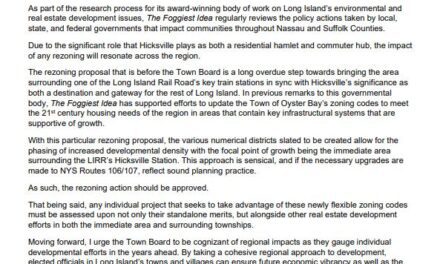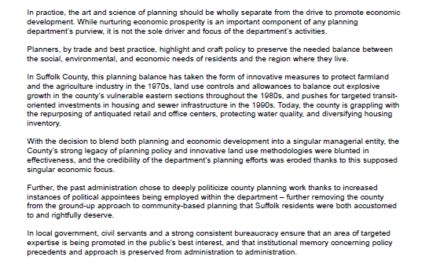The following was submitted to the Town of Oyster Bay in regards to the scoping of the environmental review for Syosset Park on June 20, 2016.
My name is Richard Murdocco. I am the founder and publisher of The Foggiest Idea, and am land use columnist who writes professionally on regional real estate development issues. I am writing to share my thoughts regarding the scoping of the Town’s environmental review for the Syosset Park mixed use development.
Overall, Syosset Park is a good option for the troubled Cerro Wire site. While the project is interesting, significant questions remain regarding the size, scope and usage of the project. The EIS documents must explore the project from all angles, and factor in the complex environmental history of the troubled site.
Moving forward, it’s critical that the Town of Oyster Bay ask in its review if Long Island’s already saturated commercial market absorb yet another 200,000 square feet of commercial office space or 355,000 square feet of retail, and if there are any opportunities for the project to be more innovative. With a dedicated economic analysis, the Town can ensure that the project is vibrant both when it opens, and decades later.
Large-scale developments are cropping up from Yaphank to Islip, Ronkonkoma to Mineola. These other projects are pitching the same benefits that are supposed to accrue from Syosset Park’s completion – it is essential that the EIS question if this project will be impacted by the others.
The review should also press the developer to work with the municipality regarding the installation of permeable surfaces for parking lots and sidewalks, and use other “green” building methods. Making some of the commercial buildings LEED-certified and energy-efficient.
Simon is pitching a phased-growth approach, which is also sound. However, the Town should require at the completion of each of the five- to six-year period phases of development that all stakeholders conduct a market study to reassess not only the community’s needs, but those of the region as well. Having a dynamic project like this can reduce the impact of vacancies, both commercial and residential, on the region. And if the analysis proves that another phase is not viable, the developer should act accordingly.
Overall, the scoping document should be data-driven and all encompassing. The opportunity to develop at this scale in Nassau County is rare, and the environmental review should be worthy of the project’s potential.












